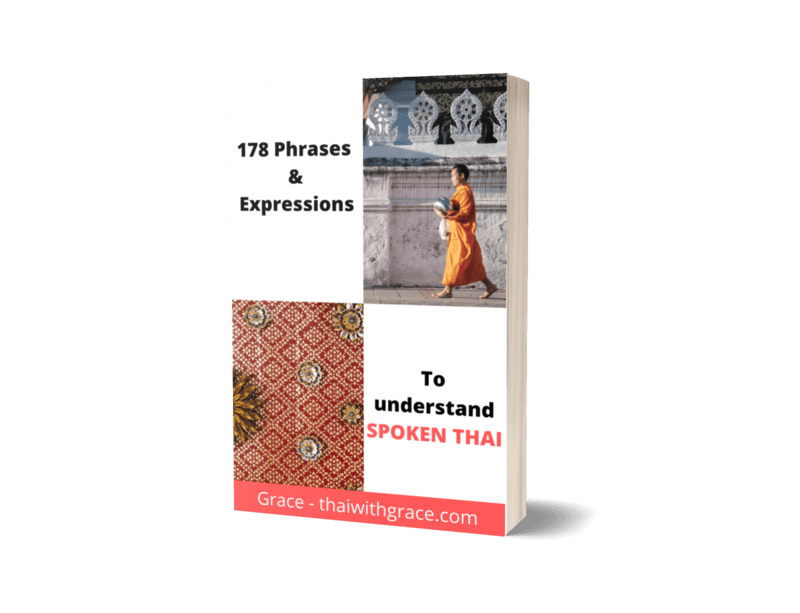Telling Time in Thai can be confusing for many foreigners. Many of my students have a hard time memorizing the different patterns needed. In this article, I will make it as easy as possible!
Telling time in Thai

Midnight and Noon
Midnight (12 AM) and Noon (12 PM) is simple enough. Midnight is เที่ยงคืน (tîang keun) and noon is just เที่ยง (tîang).
An easy trick to memorize is that คืน (keun) means night. So เที่ยงคืน (tîang keun) is the one for midnight.
Please note that you can say เที่ยงวัน (tîang wan) to mean noon. วัน simply means day, so it should be easy for you to differentiate เที่ยงคืน (tîang keun) and เที่ยงวัน (tîang wan).
1 AM – 5 AM
The pattern for 1 AM – 5 AM is ตี (dtee) followed by 1-5. For example
| 1 AM | ตีหนึ่ง | dtee nèung |
| 2 AM | ตีสอง | dtee sŏng |
| 3 AM | ตีสาม | dtee săam |
| 4 AM | ตีสี่ | dtee sèe |
| 5 AM | ตีห้า | dtee hâa |
6 AM – 11 AM
The pattern from 6 AM – 11 AM is the number 6-11 followed by โมงเช้า (mohng cháo).
โมง means o’clock and เช้า means morning. For example
| 6 AM | หกโมงเช้า | hòk mohng cháo |
| 7 AM | เจ็ดโมงเช้า | jèt mohng cháo |
| 8 AM | แปดโมงเช้า | bpàet mohng cháo |
| 9 AM | เก้าโมงเช้า | gâo mohng cháo |
| 10 AM | สิบโมงเช้า | sìp mohng cháo |
| 11 AM | สิบเอ็ดโมงเช้า | sìp èt mohng cháo |
The example below is a pattern that a lot of people (especially older people) sometimes use for 8 AM – 11 AM. This pattern isn’t standard. So just keep this one in mind.
| 8 AM | สองโมงเช้า | sŏng mohng cháo |
| 9 AM | สามโมงเช้า | săam mohng cháo |
| 10 AM | สี่โมงเช้า | sèe mohng cháo |
| 11 AM | ห้าโมงเช้า | hâa mohng cháo |
1 PM – 4 PM
The pattern for 1 PM – 4 PM is บ่าย (bàai) followed by 2-4 followed by โมง (mohng). You can use this pattern for 1 PM as well but for 1 PM you should just say บ่ายโมง (bàai mohng).
บ่าย means afternoon.
| 1 PM | บ่ายโมง | bàai mohng |
| 2 PM | บ่ายสองโมง | bàai sŏng mohng |
| 3 PM | บ่ายสามโมง | bàai săam mohng |
| 4 PM | บ่ายสี่โมง | bàai sèe mohng |
5 PM – 6 PM
The pattern for 5 PM – 6 PM is 5-6 followed by โมงเย็น (mohng yen).
เย็น means late afternoon or early evening.
| 5 PM | ห้าโมงเย็น | hâa mohng yen |
| 6 PM | หกโมงเย็น | hòk mohng yen |
7 PM – 11 PM
The pattern for 7 PM – 11 PM is the most confusing one. This is because the pattern doesn’t include 7-11. Instead, the pattern is 1-5 followed by ทุ่ม (tûm).
In this case, 1 represents 7, 2 represents 8, and so on until 5 represents 11.
An easy trick to remember this is to remember the store which is very popular in Thailand 7-11. Remember that 7-11 becomes 1-5.
| 7 PM | หนึ่งทุ่ม | nèung tûm |
| 8 PM | สองทุ่ม | sŏng tûm |
| 9 PM | สามทุ่ม | săam tûm |
| 10 PM | สี่ทุ่ม | sèe tûm |
| 11 PM | ห้าทุ่ม | hâa tûm |
Telling Minutes
To tell minutes you say the hour using the patterns explained above followed by the minutes followed by นาที (naa-tee). Please note you don’t have to use นาที (naa-tee) at the end as it is already implied.
Please note: There are 2 exceptions. For 5 PM – 6PM you omit the เย็น and for 6 AM – 11 AM you omit the เช้า (cháo).
For example:
- 6:05 PM = หกโมง ห้า นาที (hòk mohng hâa-naa-tee) <- Please note the เย็น (yen) was omitted.
- 7:20 AM = เจ็ดโมง ยี่สิบนาที (jèt mohng · yêe-sìp-naa-tee) <- Please note the เช้า (cháo) was omitted.
- 1:43 AM = ตีหนึ่ง สี่สิบสาม (dtee nèung sèe-sìp-săam) <- You can omit the นาที (naa-tee)
- 9:33 PM.= สามทุ่ม สามสิบสาม นาที (săam tûm săam-sìp-săam naa-tee)
If you want to say it is 30 minutes, then you would say ครึ่ง (krêung) which means half. For example:
- 2:30 PM = บ่ายสองโมง ครึ่ง (bàai sŏng mohng krêung)
Asking for Time
To ask for time you would say กี่โมง (gèe mohng). For example:
- Person A) กี่โมง (gèe mohng) = What time is it?
Person B) สองทุ่ม (sŏng tûm) = 8PM
Other useful vocabulary for telling time
Time in general is เวลา (way-laa).
Morning is เช้า (cháo)
Afternoon is บ่าย (bàai)
Evening is เย็น (yen)
Night is ดึก (dèuk) or ค่ำ (kâm).
You use ตอน (dton) to say in the morning, in the afternoon, in the evening, or in the night. For example ตอนเช้า (dton cháo), ตอนบ่าย (dton bàai), ตอนเย็น (dton yen), ตอนดึก (dton dèuk) or ตอนค่ำ (dton kâm)
The counter for night is คืน (keun). For example: I stayed there 3 nights.
Hour is ชั่วโมง (chûa mohng)
Minutes is นาที (naa-tee).
Seconds is วินาที (wí-naa-tee), however most Thai people just say วิ (wí).
So if you want to say 20 seconds you can say ยี่สิบวินาที or ยี่สิบวิ (yêe sìp wí).
If you want to say a long time you would say เวลานาน (way-laa naan). Please see this article for an explanation.

Summary
I hope you now know how to tell the time in Thai, ask for the time in Thai, and learned about words related to time. There are a couple of patterns to remember to tell time but try to memorize the infographic.
If you want a bit more information on why we use words like ทุ่ม and ตี to tell time, I recommend you read this article. But to summarize, these terms come from the sounds of traditional timekeeping devices, such as when you strike a drum it would make a ทุ่ม (tûm) sound.
I also have a video about telling time here:

